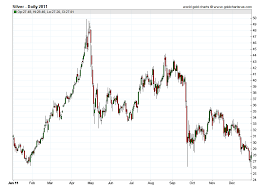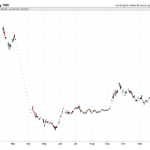In 2011, the world witnessed significant fluctuations and record highs in silver prices. This precious metal, which has been a symbol of wealth and prosperity for centuries, experienced a rollercoaster of price movements, with the highest price reaching over $49 per ounce intraday.
This article aims to explore the factors that led to these fluctuations and record highs in silver prices in 2011, providing an objective and analytical perspective on the topic.
The volatility in silver prices in 2011 had a profound impact on investors, consumers, and the global economy. For instance, the record high prices led to a surge in demand for silver as a safe investment option, while the fluctuations caused uncertainty and instability in the market.
By analyzing the factors that contributed to these price movements, we can gain a better understanding of the economic forces at play and the implications for the future of the silver market.
Overview of 2011
In 2011, the price of silver experienced significant fluctuations throughout the year. The highest price of silver was recorded on August 23rd, reaching $43.49 per ounce, while the lowest price was recorded on December 29th, dropping to $26.16 per ounce. The prices on September 23rd, 2011 also dropped significantly to $37.85 per ounce.
These fluctuations provide insight into the volatility of silver prices during this period and highlight the highly dynamic nature of the silver market.
The impact of global events on silver prices was also evident in 2011. The all-time record silver price was hit on April 28th, 2011, exceeding $49.50 per ounce intraday, after the US debt was downgraded.
In addition, the increasing demand for silver as a safe haven investment during the economic uncertainty of the time contributed to the upward trend in silver prices. Furthermore, the increasing demand for silver in the technology industry, particularly in the production of solar panels, also contributed to the rise in silver prices.
The fluctuations in silver prices in 2011 demonstrate the complex interplay of global events, market trends, and supply and demand factors that determine the value of precious metals.
Factors Affecting Prices
One notable factor influencing the value of silver in 2011 was the US debt downgrade, which led to an all-time high in gold prices and a surge in JP Morgan’s silver warehouse holdings.
The downgrade of the US credit rating by Standard & Poor’s, along with ongoing concerns about global economic conditions, sparked a surge in demand for safe-haven assets such as gold and silver.
This resulted in a record high for gold prices in August of that year, with silver prices also rising in tandem.
The surge in demand for silver was met with limited supply, as production of the metal had been declining in the years leading up to 2011.
Additionally, the rising cost of energy and other inputs had made silver mining less profitable.
This combination of factors contributed to the volatility of silver prices in 2011, with prices fluctuating throughout the year.
Despite these challenges, many analysts remain optimistic about the future of silver, citing the potential for continued supply constraints and increased demand from emerging markets.
JP Morgan’s Role
The involvement of JP Morgan in the silver market during 2011 was significant, as the bank rapidly accumulated large quantities of the metal in its COMEX warehouse. This accumulation was seen as an attempt to manipulate the silver market, as JP Morgan was accused of using its position to suppress silver prices.
The bank’s actions drew the attention of regulators and market observers, who raised concerns about the potential impact on the silver market and the wider financial system. Despite the allegations of silver manipulation, JP Morgan denied any wrongdoing and maintained that its activities were within the bounds of the law.
The bank’s role in the silver market during 2011 highlights the importance of transparency and accountability in the financial sector, particularly in relation to the trading of precious metals. The silver market continues to face challenges related to price manipulation and market volatility, underscoring the need for greater oversight and regulation to ensure fair and transparent trading practices.
Frequently Asked Questions
What were the primary drivers of the fluctuations in silver prices in 2011?
Investor behavior and market speculation were the primary drivers of fluctuations in silver prices in 2011. Silver prices were heavily influenced by supply and demand forces, with investors reacting to global economic uncertainty and geopolitical tensions. A metaphor to describe this situation would be a rollercoaster ride, with silver prices experiencing ups and downs throughout the year.
How did the silver price compare to other precious metals in 2011?
In 2011, silver prices experienced fluctuations with a highest price of $43.49 and a lowest price of $26.16. Gold also reached an all-time high. Investment options for silver versus gold can be compared based on price trends and market analysis.
What impact did global economic and political events have on silver prices in 2011?
Global economic and political events had a significant impact on silver prices in 2011, according to market analysis. The US debt downgrade, European debt crisis, and increased demand from emerging markets contributed to fluctuations and record highs in silver prices.
How did the silver market perform in terms of supply and demand in 2011?
The mining industry saw an increase in silver production in 2011, leading to a surplus of supply. However, investment options in silver remained popular due to its perceived value as a safe haven asset during times of economic uncertainty.
What strategies can investors use to take advantage of fluctuations in silver prices?
Investment strategies for taking advantage of fluctuations in silver prices involve market analysis and risk management. Diversification, dollar cost averaging, and technical analysis are commonly used approaches to mitigate volatility and optimize returns in the silver market.





